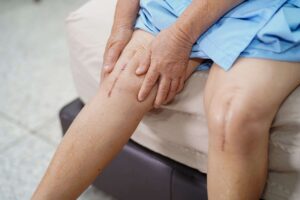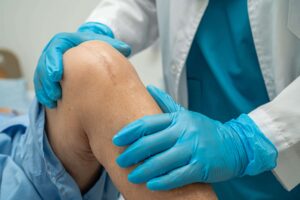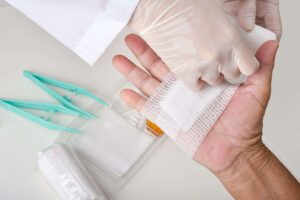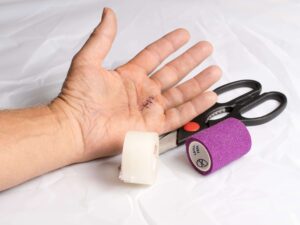Surgery doesn’t always end at the operating table. The procedure can leave you with a surgical wound (incision) to care for. A surgical wound refers to any incision made by a surgeon that has resulted in a wound or hasn’t healed properly. And the last thing you want is an infection to develop.
Most incisions heal within a couple of weeks and although your wound care specialist will provide detailed guidelines, surgical wounds still require careful oversight and wound care to minimize scars, discomfort, pain, and in the worst-case scenario, an infection.
Surgical wounds are generally closed with staples, tissue glue, stitches, and Steri-Strips (special adhesive tape). Even so, there may be occasions when the incision breaks open. That’s why it’s of the utmost importance to educate yourself on proper wound care and management techniques to avoid any complications after surgery.
Post-Surgery Wound Care 101
 Wound care after surgery plays an important role in the recovery process; helping prevent infection, reducing scarring, and promoting healing. Generally speaking, proper wound care following surgery involves:
Wound care after surgery plays an important role in the recovery process; helping prevent infection, reducing scarring, and promoting healing. Generally speaking, proper wound care following surgery involves:
- Keeping the wound dry
- Cleaning the wound
- Regularly changing the dressing
- Caring for wound closers like stitches and staples
- Looking out for infections
- Other general recommendations
In light of its importance, throughout this guide, we take a more in-depth look at the proper way to care for surgical wounds after a procedure and the crucial steps to take to help keep your injury clean and safe as it heals.
How Surgical Wounds Heal
Generally, there are three ways in which surgical wounds heal:
- Primary healing – all layers of skin are closed and the wound is clean.
- Secondary healing – while the deeper layers of the wound are closed, the layers above it are left open.
- Tertiary healing – Once the wound has been cleaned, it is closely watched for signs of infection before it is closed.
Keeping the Wound Dry
 Incisions may vary in depth and width, and your wound care specialist can provide personalized guidelines for caring for them depending on your individual situation. In any case, it’s recommended to ensure the surgical wound doesn’t become wet within the first 24 hours following surgery. As such, it’s best to avoid showers or baths. If you must, a sponge bath may be a viable option.
Incisions may vary in depth and width, and your wound care specialist can provide personalized guidelines for caring for them depending on your individual situation. In any case, it’s recommended to ensure the surgical wound doesn’t become wet within the first 24 hours following surgery. As such, it’s best to avoid showers or baths. If you must, a sponge bath may be a viable option.
After 24 hours, it is up to your wound specialist whether it is okay to start rinsing your wound with water, depending on the type of operation you had and the site of the wound. If the doctor allows it, opt for a shower over a bath to prevent soaking the wound, which can soften and cause it to open.
If your doctor still recommends avoiding showers you can try covering it with a plastic bag to keep it dry.
Remove any incision dressings before you shower, unless your dressing is waterproof or you are instructed otherwise. You can gently rinse the incision with water as you shower, but try not to scrub or rub the wound or apply shampoo, lotion, or other bath products.
Cleaning the Wound
Incisions require regular cleaning so that they don’t develop into a nidus for bacterial growth. To start, it’s recommended to clean the skin around the injury with a gauze pad or a soft cloth soaked in mild soapy water or a saline solution (salt and water mixture).
Gently dab and wipe the skin (instead of rubbing it) to get rid of any dried blood, fluids from the wound, and other matter accumulated on the skin.
Avoid Hydrogen peroxide, iodine, soap containing antibacterial chemicals, rubbing alcohol, and skin cleansers to minimize tissue damage.
When cleaning the wound itself, the procedure is generally the same. Gently wash it with soap and water to remove the crust without scrubbing or soaking it.
You can air-dry or pat the area with a clean towel before changing the dressing. Like the skin surrounding the wound, lotions, creams, and herbal remedies should be avoided, unless specifically instructed by your healthcare practitioner or wound care specialist.
In some cases, your specialist may recommend washing out or irrigating the wound, which is usually done with a syringe full of saline or soapy water.
Changing Wound Dressings
 Another name for a bandage, a dressing creates an ideal environment for healing by absorbing drainage and preventing skin closure before the wound has successfully filled in. Wound dressings minimize the risk of infection, protect against germs, and cover the wound so stitches/staples do not catch onto clothing among other things.
Another name for a bandage, a dressing creates an ideal environment for healing by absorbing drainage and preventing skin closure before the wound has successfully filled in. Wound dressings minimize the risk of infection, protect against germs, and cover the wound so stitches/staples do not catch onto clothing among other things.
Given its importance to the healing process, it is not only crucial to regularly change your dressings but it also needs to be done the right way. Your wound specialist will provide specific instructions on when and how often to change your dressing. While most wounds might not need to remain covered for extended periods, keeping it covered is still a good idea to protect the injury.
Although, you should ask your wound specialist for detailed instructions, here are a few tips for changing wound dressings you can follow:
Remember to make sure to take any jewelry off your hands and clean them with water (you can add an alcohol-based cleanser) beforehand. Ensure you clean under your nails as well, and grab all required supplies, which can include:
- Gauze pads
- Surgical tape
- Plastic bag for disposal
- Medical gloves
- Scissors
Once you have opened the gauze packages, cut new tape strips and put on clean medical gloves, loosen the tape around the old dressing and gently pull it off. If it sticks to the wound, you can try wetting it unless you have been specifically instructed to remove it dry.
After doing so, clean the incision as described above. Look for any signs of infection, and if your physician has asked you to apply an ointment or medicine, you can do so now.
Next, open the gauze package without touching the gauze. Hold it by the corner and place it over the surgical wound before taping all four sides. You can dispose of the trash, including the old dressing, in a plastic bag before washing your hands again.
Avoid touching the inside of the dressing, old or new.
Wound Care for Stitches, Staples and Tissue Glue
 In most cases, some degree of redness, swelling, and itching around the wound site following getting stitches is normal. For the first few days, you might also see some drainage around the area. However, if this continues or if it starts to bleed or pus, get in touch with your wound care specialist as soon as possible.
In most cases, some degree of redness, swelling, and itching around the wound site following getting stitches is normal. For the first few days, you might also see some drainage around the area. However, if this continues or if it starts to bleed or pus, get in touch with your wound care specialist as soon as possible.
When it comes to wound care for stitches or staples, they generally require the same cleaning instructions as above. Some stitches dissolve within 7 to 10 days. And non-dissolvable ones are removed by a doctor usually 5 to 21 days after the surgery. Never attempt to remove stitches on your own.
On the contrary, if tissue glue was used, it’s important to keep it dry. If it gets wet, dry it immediately, as moisture may limit its efficacy. It will dry out and take care of itself in about 5 to 10 days. Similarly, adhesive strips should also loosen and fall off over time.
Looking Out for Infection
As we referenced earlier, after a surgical procedure, it’s crucial to regularly check the wound for any signs of infection so it can be treated as soon as possible.
Infection is always a risk after surgery but it’s even more important to be wary of if you have conditions such as diabetes, a weak immune system, obesity, a history of smoking, or other risk factors that could impair healing.
If you notice any of the following signs contact a doctor or wound care specialist as soon as possible:
- A green, yellow, white, cream, or opaque discharge
- Foul-smelling odor
- Increase in incision size (longer, wider, or deeper)
- Hardening, redness, or darkening of the surrounding area
- Warmth around the incision
- Unusual and growing pain
- Increased bleeding
Temperature higher than 100.5°F (38°C) for more than 4 hours can also be a cause of concern.
Additional Post-Surgical Wound Care Tips
Depending on the type of surgery, your specialist may give you other specific instructions. Make sure to follow them carefully and ask any questions you might have. That said, in addition to the guidelines discussed above, there are a few steps wound care specialists recommend taking after a surgical procedure to help the healing process:
- Avoid wearing any tight clothing that rubs against the surgical wound.
- Do not scratch your wound, regardless of how itchy (which it will be) it may feel.
- Try not to expose your wound to direct sunlight for 3 to 9 months after the operation. The new skin may be more sensitive to sunlight and excessive exposure could result in further scarring.
- If your wound bleeds, directly apply pressure on it for a few minutes before replacing the bloody dressing. If it doesn’t stop, contact your doctor.
- Limit movement of the area surrounding the incision to lessen the risk of the wound opening. Lifting exercises and sports are particularly ill-advised, but light movement may be fine.
- Get plenty of rest.
- Eat a nutritious diet to ensure your body has sufficient energy to heal.
- Remember to stay hydrated.
- Avoid smoking or using tobacco products that could slow healing.
Most people recover from surgical wounds with minimal scarring. If you would like to learn more about minimizing scarring we highly recommend our guide discussing wound care and healing scars.
Promoting Healing Through Proper Wound Care
Proper wound care after surgery is essential to efficient healing and recovery. By following your wound care specialists’ advice for cleaning and dressing your wound, and preventing complications you can help promote healing and even reduce scarring.
If you recently have had surgery or are caring for someone who has and have questions on proper wound care; the specialists at West Coast Wound Center are here to help. We are specialized wound and skin care physicians with expertise in treating a complete range of wound types and skin concerns. Book an appointment today and find out how we can help restore your quality of life.
